Kouzes and Posner's Model: Application of Leadership Skills Future
VerifiedAdded on 2023/03/23
|13
|3535
|53
Essay
AI Summary
This essay delves into the concept of exemplary leadership through the lens of Kouzes and Posner's functional leadership model, which encompasses five key practices: modeling the way, inspiring a shared vision, challenging the process, enabling others to act, and encouraging the heart. Each practice is associated with specific commitments and behaviors that leaders should adopt to foster a positive organizational culture and drive high performance. The author reflects on their future role as a leader, outlining how they intend to apply these principles to cultivate a shared vision, challenge existing systems, and empower individuals within their organization. The essay also contrasts exemplary leadership with other styles, highlighting its suitability for dynamic business environments and its focus on both short-term and long-term organizational success. It emphasizes the importance of employee motivation, engagement, and recognition in achieving high-performance outcomes, drawing upon the author's personal experiences in the healthcare sector to illustrate the impact of leadership on employee retention and team performance.
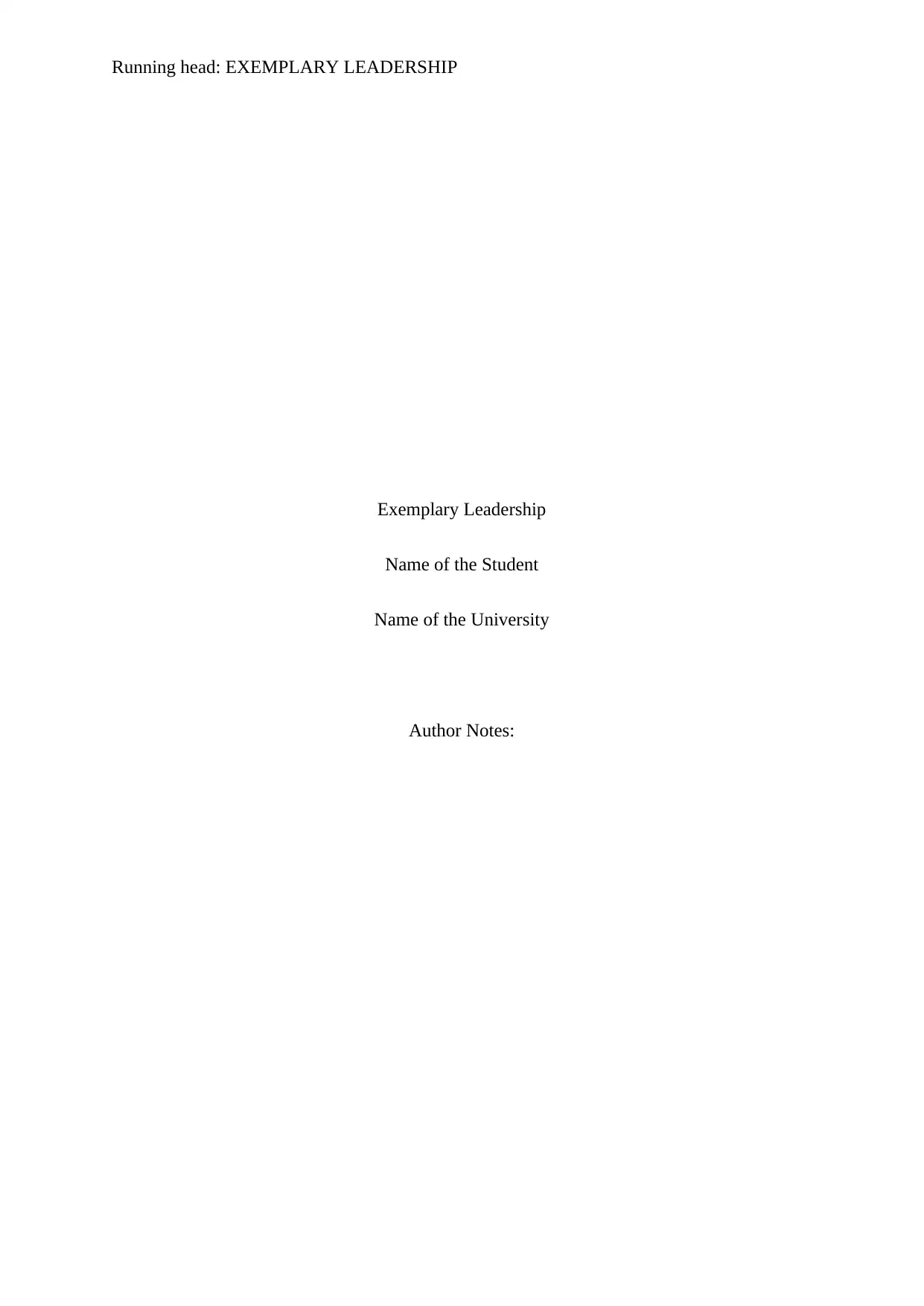
Running head: EXEMPLARY LEADERSHIP
Exemplary Leadership
Name of the Student
Name of the University
Author Notes:
Exemplary Leadership
Name of the Student
Name of the University
Author Notes:
Paraphrase This Document
Need a fresh take? Get an instant paraphrase of this document with our AI Paraphraser
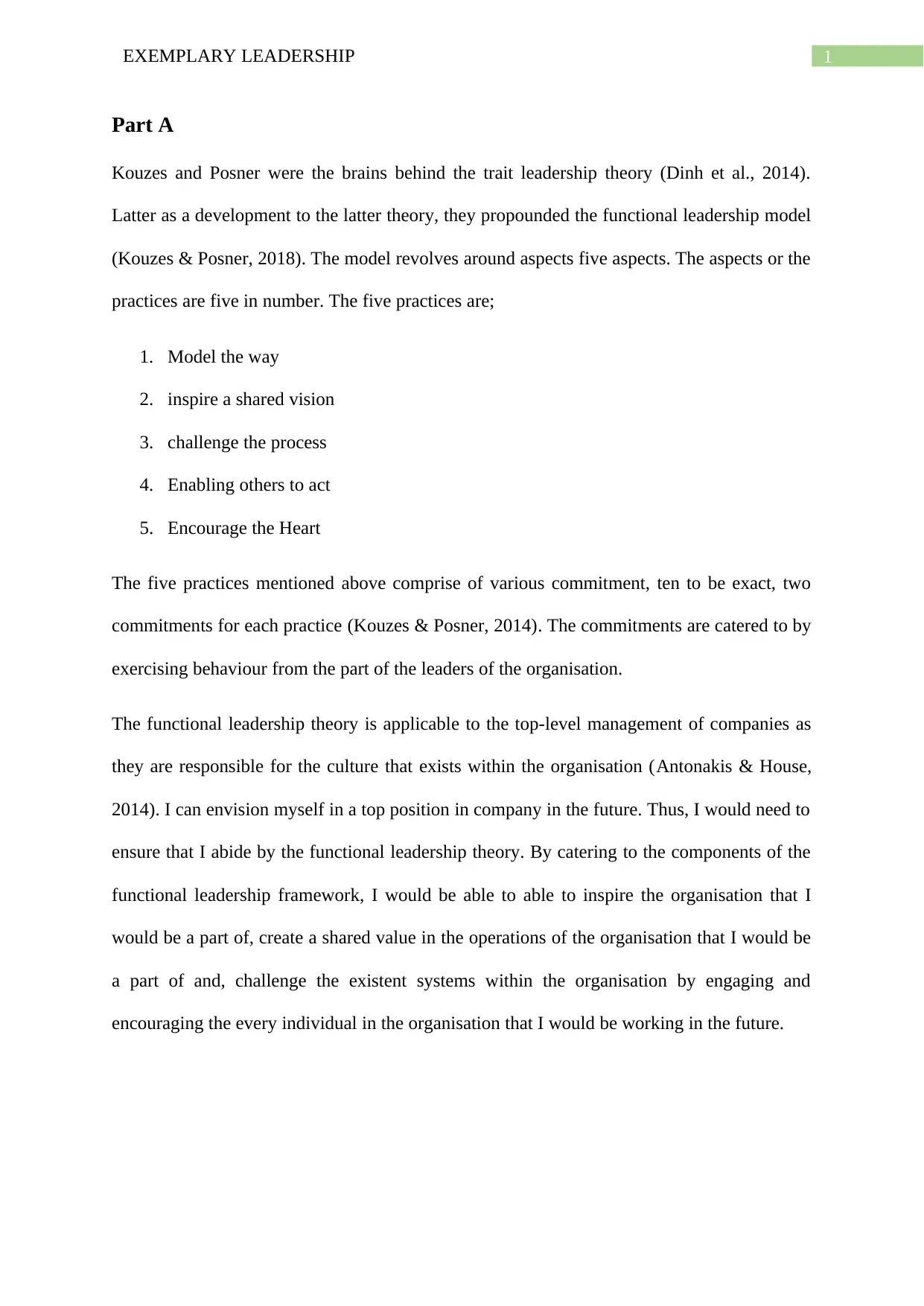
1EXEMPLARY LEADERSHIP
Part A
Kouzes and Posner were the brains behind the trait leadership theory (Dinh et al., 2014).
Latter as a development to the latter theory, they propounded the functional leadership model
(Kouzes & Posner, 2018). The model revolves around aspects five aspects. The aspects or the
practices are five in number. The five practices are;
1. Model the way
2. inspire a shared vision
3. challenge the process
4. Enabling others to act
5. Encourage the Heart
The five practices mentioned above comprise of various commitment, ten to be exact, two
commitments for each practice (Kouzes & Posner, 2014). The commitments are catered to by
exercising behaviour from the part of the leaders of the organisation.
The functional leadership theory is applicable to the top-level management of companies as
they are responsible for the culture that exists within the organisation (Antonakis & House,
2014). I can envision myself in a top position in company in the future. Thus, I would need to
ensure that I abide by the functional leadership theory. By catering to the components of the
functional leadership framework, I would be able to able to inspire the organisation that I
would be a part of, create a shared value in the operations of the organisation that I would be
a part of and, challenge the existent systems within the organisation by engaging and
encouraging the every individual in the organisation that I would be working in the future.
Part A
Kouzes and Posner were the brains behind the trait leadership theory (Dinh et al., 2014).
Latter as a development to the latter theory, they propounded the functional leadership model
(Kouzes & Posner, 2018). The model revolves around aspects five aspects. The aspects or the
practices are five in number. The five practices are;
1. Model the way
2. inspire a shared vision
3. challenge the process
4. Enabling others to act
5. Encourage the Heart
The five practices mentioned above comprise of various commitment, ten to be exact, two
commitments for each practice (Kouzes & Posner, 2014). The commitments are catered to by
exercising behaviour from the part of the leaders of the organisation.
The functional leadership theory is applicable to the top-level management of companies as
they are responsible for the culture that exists within the organisation (Antonakis & House,
2014). I can envision myself in a top position in company in the future. Thus, I would need to
ensure that I abide by the functional leadership theory. By catering to the components of the
functional leadership framework, I would be able to able to inspire the organisation that I
would be a part of, create a shared value in the operations of the organisation that I would be
a part of and, challenge the existent systems within the organisation by engaging and
encouraging the every individual in the organisation that I would be working in the future.
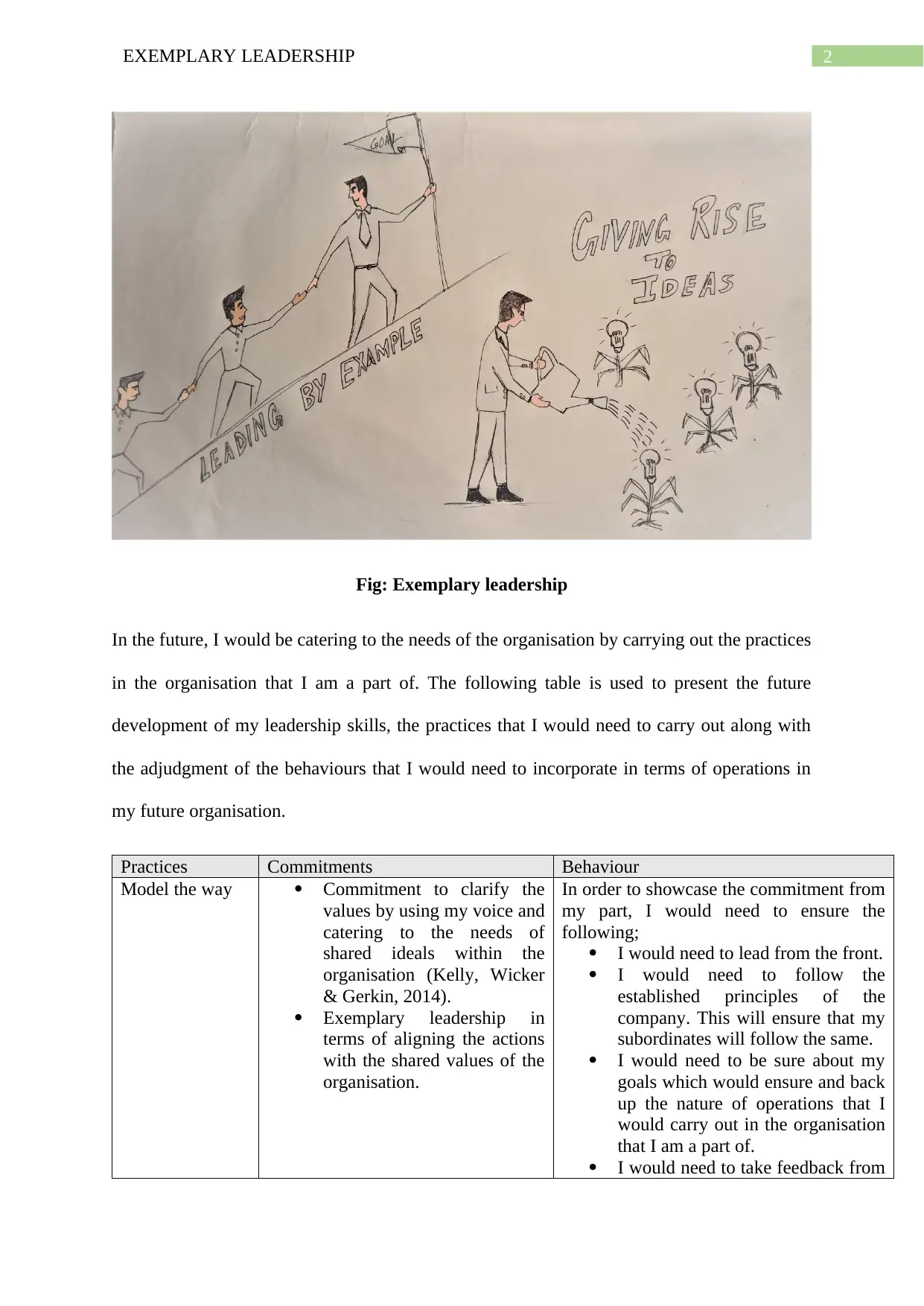
2EXEMPLARY LEADERSHIP
Fig: Exemplary leadership
In the future, I would be catering to the needs of the organisation by carrying out the practices
in the organisation that I am a part of. The following table is used to present the future
development of my leadership skills, the practices that I would need to carry out along with
the adjudgment of the behaviours that I would need to incorporate in terms of operations in
my future organisation.
Practices Commitments Behaviour
Model the way Commitment to clarify the
values by using my voice and
catering to the needs of
shared ideals within the
organisation (Kelly, Wicker
& Gerkin, 2014).
Exemplary leadership in
terms of aligning the actions
with the shared values of the
organisation.
In order to showcase the commitment from
my part, I would need to ensure the
following;
I would need to lead from the front.
I would need to follow the
established principles of the
company. This will ensure that my
subordinates will follow the same.
I would need to be sure about my
goals which would ensure and back
up the nature of operations that I
would carry out in the organisation
that I am a part of.
I would need to take feedback from
Fig: Exemplary leadership
In the future, I would be catering to the needs of the organisation by carrying out the practices
in the organisation that I am a part of. The following table is used to present the future
development of my leadership skills, the practices that I would need to carry out along with
the adjudgment of the behaviours that I would need to incorporate in terms of operations in
my future organisation.
Practices Commitments Behaviour
Model the way Commitment to clarify the
values by using my voice and
catering to the needs of
shared ideals within the
organisation (Kelly, Wicker
& Gerkin, 2014).
Exemplary leadership in
terms of aligning the actions
with the shared values of the
organisation.
In order to showcase the commitment from
my part, I would need to ensure the
following;
I would need to lead from the front.
I would need to follow the
established principles of the
company. This will ensure that my
subordinates will follow the same.
I would need to be sure about my
goals which would ensure and back
up the nature of operations that I
would carry out in the organisation
that I am a part of.
I would need to take feedback from
⊘ This is a preview!⊘
Do you want full access?
Subscribe today to unlock all pages.

Trusted by 1+ million students worldwide
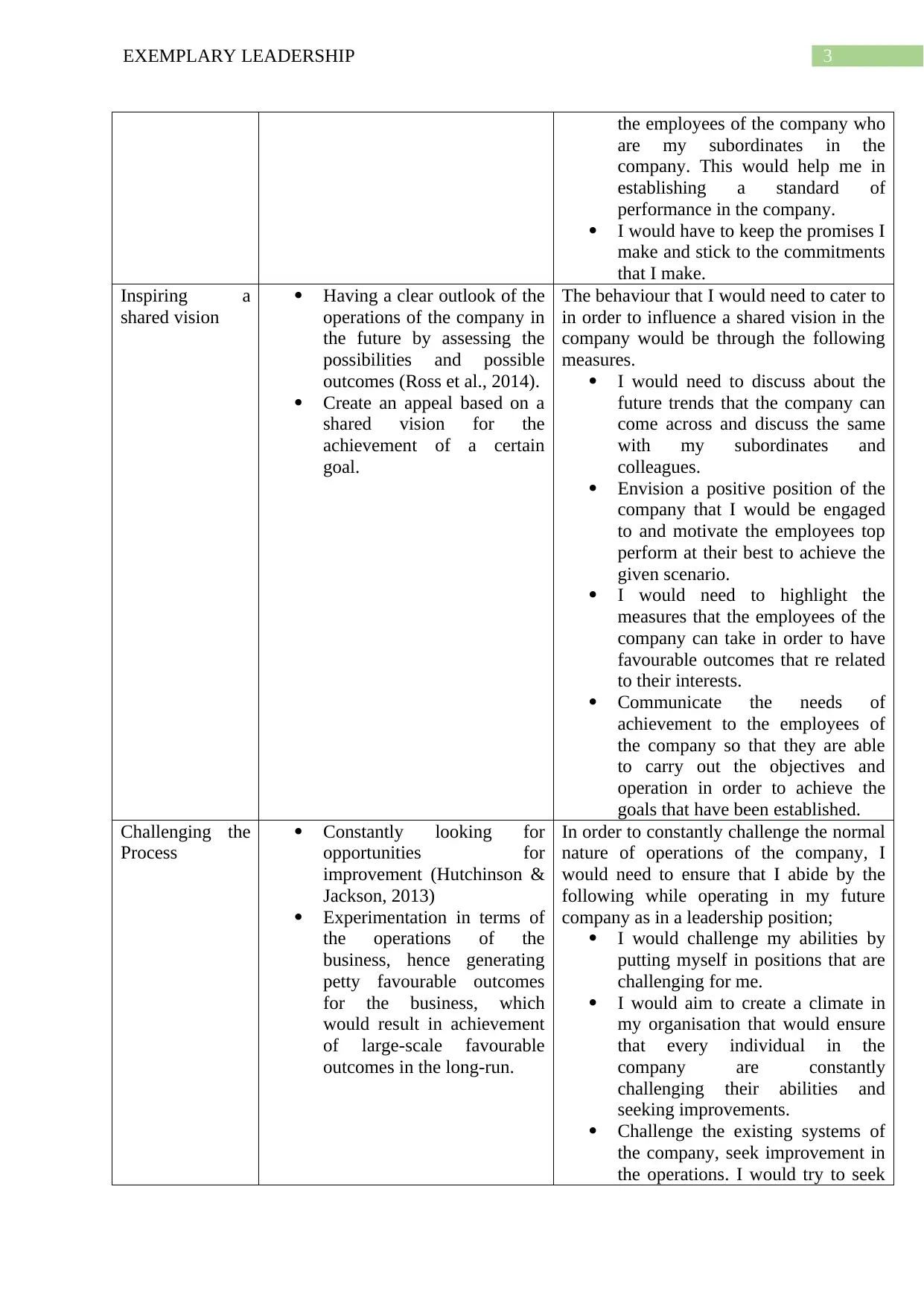
3EXEMPLARY LEADERSHIP
the employees of the company who
are my subordinates in the
company. This would help me in
establishing a standard of
performance in the company.
I would have to keep the promises I
make and stick to the commitments
that I make.
Inspiring a
shared vision
Having a clear outlook of the
operations of the company in
the future by assessing the
possibilities and possible
outcomes (Ross et al., 2014).
Create an appeal based on a
shared vision for the
achievement of a certain
goal.
The behaviour that I would need to cater to
in order to influence a shared vision in the
company would be through the following
measures.
I would need to discuss about the
future trends that the company can
come across and discuss the same
with my subordinates and
colleagues.
Envision a positive position of the
company that I would be engaged
to and motivate the employees top
perform at their best to achieve the
given scenario.
I would need to highlight the
measures that the employees of the
company can take in order to have
favourable outcomes that re related
to their interests.
Communicate the needs of
achievement to the employees of
the company so that they are able
to carry out the objectives and
operation in order to achieve the
goals that have been established.
Challenging the
Process
Constantly looking for
opportunities for
improvement (Hutchinson &
Jackson, 2013)
Experimentation in terms of
the operations of the
business, hence generating
petty favourable outcomes
for the business, which
would result in achievement
of large-scale favourable
outcomes in the long-run.
In order to constantly challenge the normal
nature of operations of the company, I
would need to ensure that I abide by the
following while operating in my future
company as in a leadership position;
I would challenge my abilities by
putting myself in positions that are
challenging for me.
I would aim to create a climate in
my organisation that would ensure
that every individual in the
company are constantly
challenging their abilities and
seeking improvements.
Challenge the existing systems of
the company, seek improvement in
the operations. I would try to seek
the employees of the company who
are my subordinates in the
company. This would help me in
establishing a standard of
performance in the company.
I would have to keep the promises I
make and stick to the commitments
that I make.
Inspiring a
shared vision
Having a clear outlook of the
operations of the company in
the future by assessing the
possibilities and possible
outcomes (Ross et al., 2014).
Create an appeal based on a
shared vision for the
achievement of a certain
goal.
The behaviour that I would need to cater to
in order to influence a shared vision in the
company would be through the following
measures.
I would need to discuss about the
future trends that the company can
come across and discuss the same
with my subordinates and
colleagues.
Envision a positive position of the
company that I would be engaged
to and motivate the employees top
perform at their best to achieve the
given scenario.
I would need to highlight the
measures that the employees of the
company can take in order to have
favourable outcomes that re related
to their interests.
Communicate the needs of
achievement to the employees of
the company so that they are able
to carry out the objectives and
operation in order to achieve the
goals that have been established.
Challenging the
Process
Constantly looking for
opportunities for
improvement (Hutchinson &
Jackson, 2013)
Experimentation in terms of
the operations of the
business, hence generating
petty favourable outcomes
for the business, which
would result in achievement
of large-scale favourable
outcomes in the long-run.
In order to constantly challenge the normal
nature of operations of the company, I
would need to ensure that I abide by the
following while operating in my future
company as in a leadership position;
I would challenge my abilities by
putting myself in positions that are
challenging for me.
I would aim to create a climate in
my organisation that would ensure
that every individual in the
company are constantly
challenging their abilities and
seeking improvements.
Challenge the existing systems of
the company, seek improvement in
the operations. I would try to seek
Paraphrase This Document
Need a fresh take? Get an instant paraphrase of this document with our AI Paraphraser

4EXEMPLARY LEADERSHIP
opportunities to improve even if the
company I am part of is performing
favourably.
Carry out experimentation in the
general nature of operations of the
company and I would think out of
the box in terms of catering to the
satiation of the stakeholders of the
company.
Empower others
to act
Building an atmosphere of
trust in the company
Enriching the competency of
the employees of the
organisation and
strengthening the
determination of the
employees engaged in the
operations of an organisation
(Jones et al., 2015).
In order to provide all the employees of the
company to act, I would need to follow the
following nature of behaviour;
Develop favourable interpersonal
relationships with the employees.
I would have to treat everyone in
the company with dignity and due
respect.
I would give all the employees of
the company opportunity to express
themselves.
I would ensure policies in the
organisation that help the people of
the company to speak their minds
by establishing a network of
smooth communication the
company.
Ensure that the people of the
company experience growth in
their positions.
Encourage the
Heart
Acknowledging good
performances and showing
appreciation for the same
(Staib & Burkman, 2015).
Creation of a sense of
community that would help
in abiding by the values of
the company.
In order to encourage the heart, I would
need to ensure that I have to behave in the
following way I while operating in the
company;
I need to appreciate the employees
on favourable performances.
I should be able to communicate
the fact that I trust in their abilities
through which the employees will
gain motivation in performing the
jobs.
I would make sure that I
incorporate reward schemes in the
operation of the company in order
to cater to the favourable
performances.
I would need to develop or
introduce policies that help in the
recognising the achievement of the
employee publicly.
I would provide adequate
opportunities to improve even if the
company I am part of is performing
favourably.
Carry out experimentation in the
general nature of operations of the
company and I would think out of
the box in terms of catering to the
satiation of the stakeholders of the
company.
Empower others
to act
Building an atmosphere of
trust in the company
Enriching the competency of
the employees of the
organisation and
strengthening the
determination of the
employees engaged in the
operations of an organisation
(Jones et al., 2015).
In order to provide all the employees of the
company to act, I would need to follow the
following nature of behaviour;
Develop favourable interpersonal
relationships with the employees.
I would have to treat everyone in
the company with dignity and due
respect.
I would give all the employees of
the company opportunity to express
themselves.
I would ensure policies in the
organisation that help the people of
the company to speak their minds
by establishing a network of
smooth communication the
company.
Ensure that the people of the
company experience growth in
their positions.
Encourage the
Heart
Acknowledging good
performances and showing
appreciation for the same
(Staib & Burkman, 2015).
Creation of a sense of
community that would help
in abiding by the values of
the company.
In order to encourage the heart, I would
need to ensure that I have to behave in the
following way I while operating in the
company;
I need to appreciate the employees
on favourable performances.
I should be able to communicate
the fact that I trust in their abilities
through which the employees will
gain motivation in performing the
jobs.
I would make sure that I
incorporate reward schemes in the
operation of the company in order
to cater to the favourable
performances.
I would need to develop or
introduce policies that help in the
recognising the achievement of the
employee publicly.
I would provide adequate
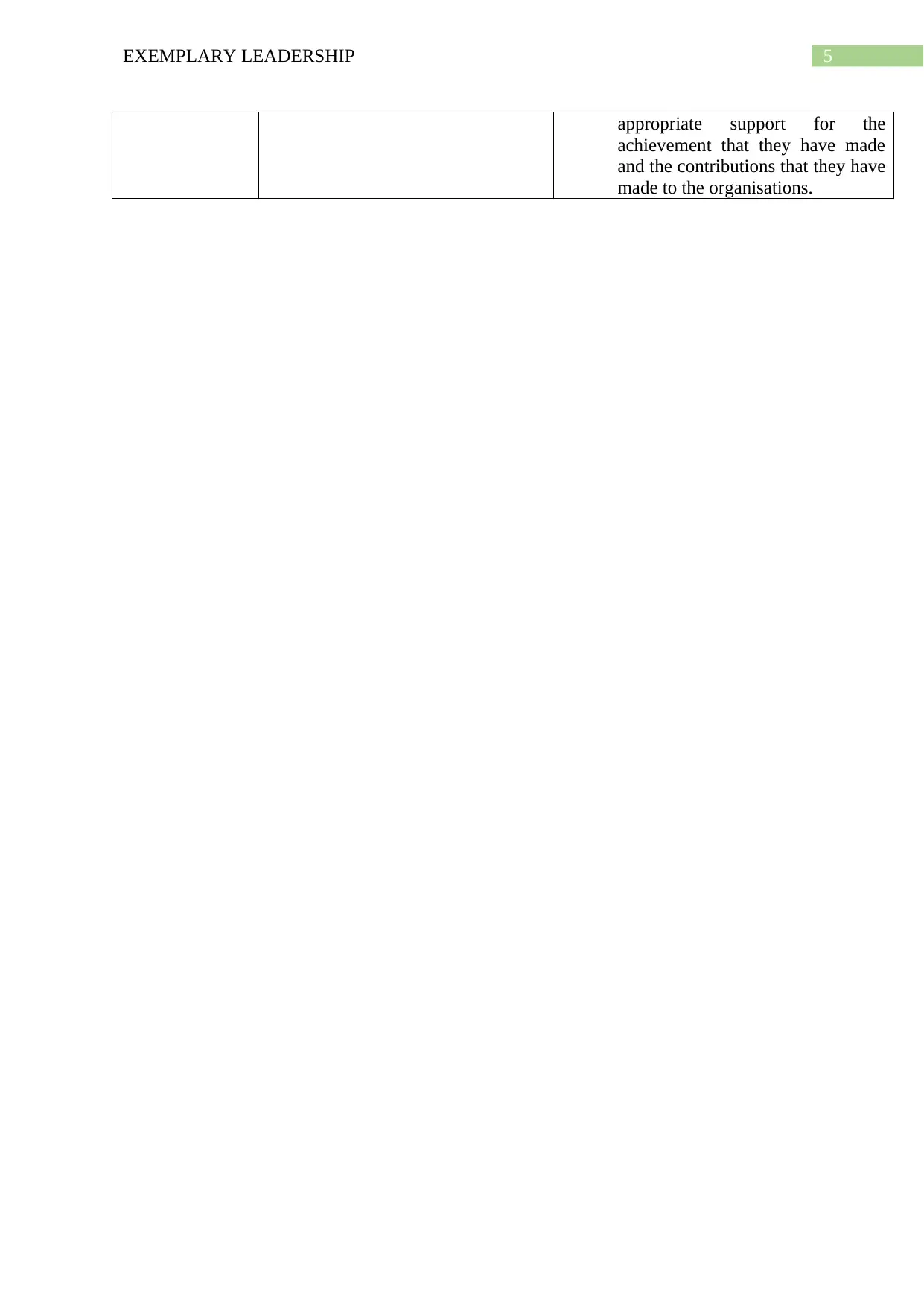
5EXEMPLARY LEADERSHIP
appropriate support for the
achievement that they have made
and the contributions that they have
made to the organisations.
appropriate support for the
achievement that they have made
and the contributions that they have
made to the organisations.
⊘ This is a preview!⊘
Do you want full access?
Subscribe today to unlock all pages.

Trusted by 1+ million students worldwide
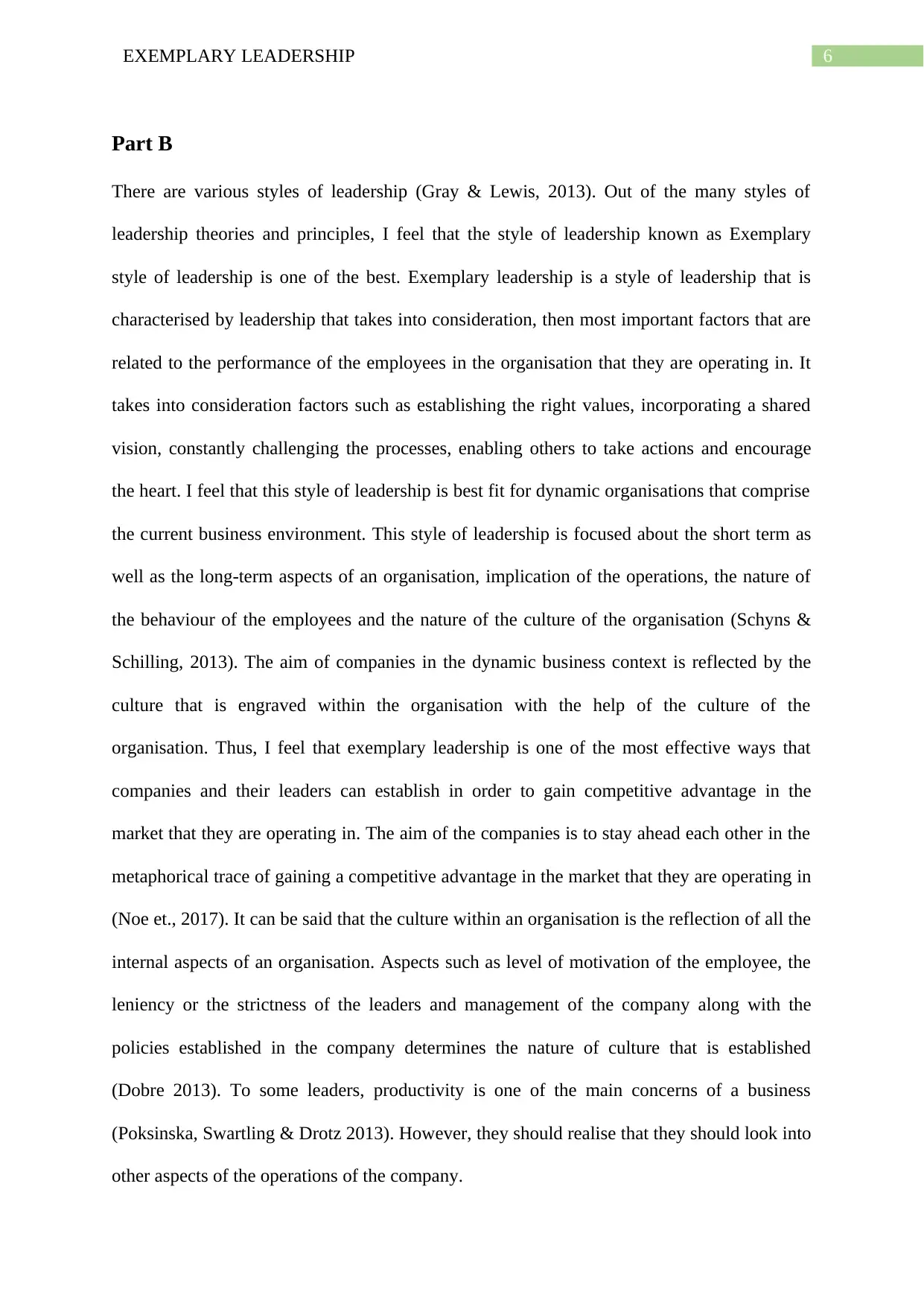
6EXEMPLARY LEADERSHIP
Part B
There are various styles of leadership (Gray & Lewis, 2013). Out of the many styles of
leadership theories and principles, I feel that the style of leadership known as Exemplary
style of leadership is one of the best. Exemplary leadership is a style of leadership that is
characterised by leadership that takes into consideration, then most important factors that are
related to the performance of the employees in the organisation that they are operating in. It
takes into consideration factors such as establishing the right values, incorporating a shared
vision, constantly challenging the processes, enabling others to take actions and encourage
the heart. I feel that this style of leadership is best fit for dynamic organisations that comprise
the current business environment. This style of leadership is focused about the short term as
well as the long-term aspects of an organisation, implication of the operations, the nature of
the behaviour of the employees and the nature of the culture of the organisation (Schyns &
Schilling, 2013). The aim of companies in the dynamic business context is reflected by the
culture that is engraved within the organisation with the help of the culture of the
organisation. Thus, I feel that exemplary leadership is one of the most effective ways that
companies and their leaders can establish in order to gain competitive advantage in the
market that they are operating in. The aim of the companies is to stay ahead each other in the
metaphorical trace of gaining a competitive advantage in the market that they are operating in
(Noe et., 2017). It can be said that the culture within an organisation is the reflection of all the
internal aspects of an organisation. Aspects such as level of motivation of the employee, the
leniency or the strictness of the leaders and management of the company along with the
policies established in the company determines the nature of culture that is established
(Dobre 2013). To some leaders, productivity is one of the main concerns of a business
(Poksinska, Swartling & Drotz 2013). However, they should realise that they should look into
other aspects of the operations of the company.
Part B
There are various styles of leadership (Gray & Lewis, 2013). Out of the many styles of
leadership theories and principles, I feel that the style of leadership known as Exemplary
style of leadership is one of the best. Exemplary leadership is a style of leadership that is
characterised by leadership that takes into consideration, then most important factors that are
related to the performance of the employees in the organisation that they are operating in. It
takes into consideration factors such as establishing the right values, incorporating a shared
vision, constantly challenging the processes, enabling others to take actions and encourage
the heart. I feel that this style of leadership is best fit for dynamic organisations that comprise
the current business environment. This style of leadership is focused about the short term as
well as the long-term aspects of an organisation, implication of the operations, the nature of
the behaviour of the employees and the nature of the culture of the organisation (Schyns &
Schilling, 2013). The aim of companies in the dynamic business context is reflected by the
culture that is engraved within the organisation with the help of the culture of the
organisation. Thus, I feel that exemplary leadership is one of the most effective ways that
companies and their leaders can establish in order to gain competitive advantage in the
market that they are operating in. The aim of the companies is to stay ahead each other in the
metaphorical trace of gaining a competitive advantage in the market that they are operating in
(Noe et., 2017). It can be said that the culture within an organisation is the reflection of all the
internal aspects of an organisation. Aspects such as level of motivation of the employee, the
leniency or the strictness of the leaders and management of the company along with the
policies established in the company determines the nature of culture that is established
(Dobre 2013). To some leaders, productivity is one of the main concerns of a business
(Poksinska, Swartling & Drotz 2013). However, they should realise that they should look into
other aspects of the operations of the company.
Paraphrase This Document
Need a fresh take? Get an instant paraphrase of this document with our AI Paraphraser
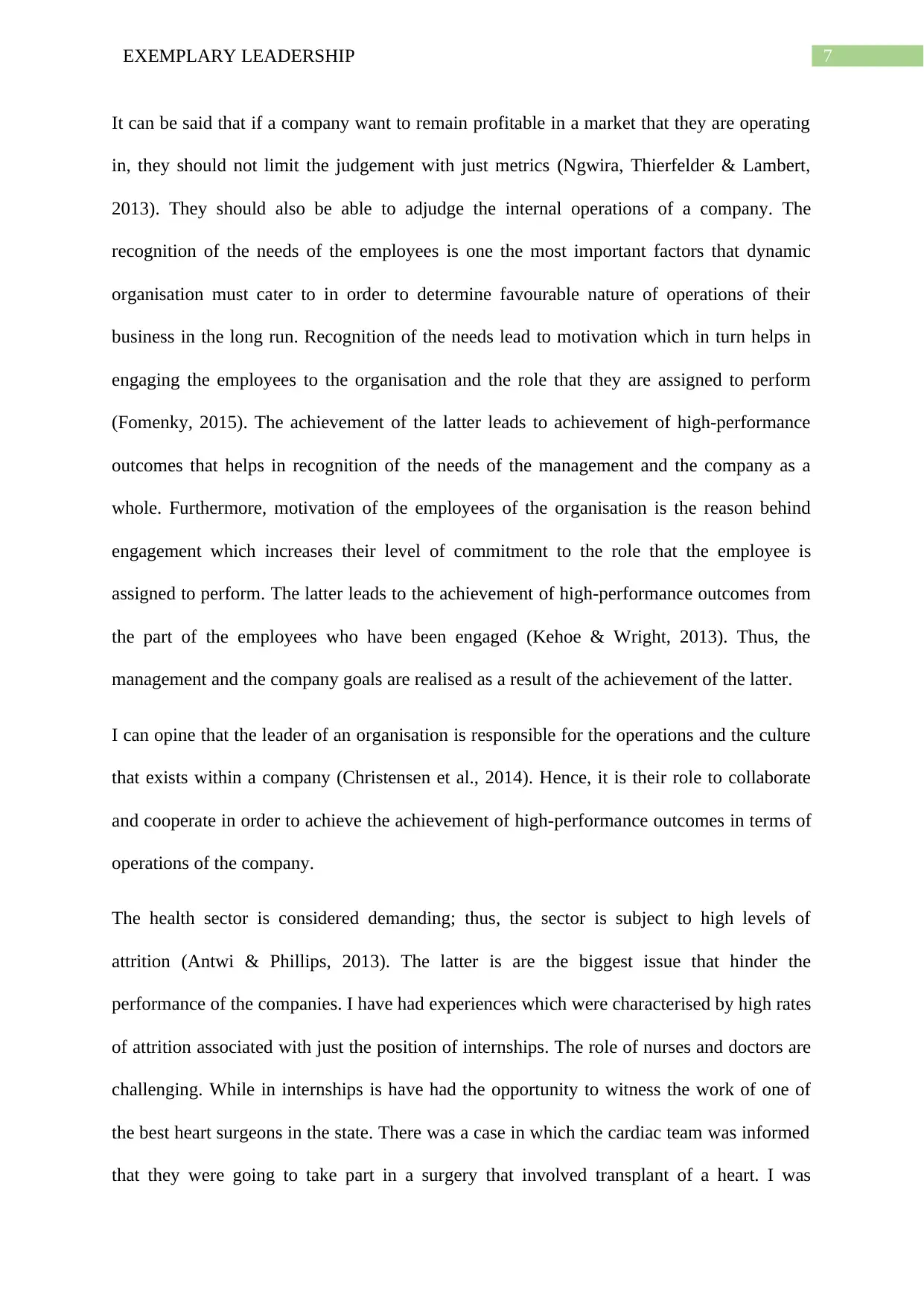
7EXEMPLARY LEADERSHIP
It can be said that if a company want to remain profitable in a market that they are operating
in, they should not limit the judgement with just metrics (Ngwira, Thierfelder & Lambert,
2013). They should also be able to adjudge the internal operations of a company. The
recognition of the needs of the employees is one the most important factors that dynamic
organisation must cater to in order to determine favourable nature of operations of their
business in the long run. Recognition of the needs lead to motivation which in turn helps in
engaging the employees to the organisation and the role that they are assigned to perform
(Fomenky, 2015). The achievement of the latter leads to achievement of high-performance
outcomes that helps in recognition of the needs of the management and the company as a
whole. Furthermore, motivation of the employees of the organisation is the reason behind
engagement which increases their level of commitment to the role that the employee is
assigned to perform. The latter leads to the achievement of high-performance outcomes from
the part of the employees who have been engaged (Kehoe & Wright, 2013). Thus, the
management and the company goals are realised as a result of the achievement of the latter.
I can opine that the leader of an organisation is responsible for the operations and the culture
that exists within a company (Christensen et al., 2014). Hence, it is their role to collaborate
and cooperate in order to achieve the achievement of high-performance outcomes in terms of
operations of the company.
The health sector is considered demanding; thus, the sector is subject to high levels of
attrition (Antwi & Phillips, 2013). The latter is are the biggest issue that hinder the
performance of the companies. I have had experiences which were characterised by high rates
of attrition associated with just the position of internships. The role of nurses and doctors are
challenging. While in internships is have had the opportunity to witness the work of one of
the best heart surgeons in the state. There was a case in which the cardiac team was informed
that they were going to take part in a surgery that involved transplant of a heart. I was
It can be said that if a company want to remain profitable in a market that they are operating
in, they should not limit the judgement with just metrics (Ngwira, Thierfelder & Lambert,
2013). They should also be able to adjudge the internal operations of a company. The
recognition of the needs of the employees is one the most important factors that dynamic
organisation must cater to in order to determine favourable nature of operations of their
business in the long run. Recognition of the needs lead to motivation which in turn helps in
engaging the employees to the organisation and the role that they are assigned to perform
(Fomenky, 2015). The achievement of the latter leads to achievement of high-performance
outcomes that helps in recognition of the needs of the management and the company as a
whole. Furthermore, motivation of the employees of the organisation is the reason behind
engagement which increases their level of commitment to the role that the employee is
assigned to perform. The latter leads to the achievement of high-performance outcomes from
the part of the employees who have been engaged (Kehoe & Wright, 2013). Thus, the
management and the company goals are realised as a result of the achievement of the latter.
I can opine that the leader of an organisation is responsible for the operations and the culture
that exists within a company (Christensen et al., 2014). Hence, it is their role to collaborate
and cooperate in order to achieve the achievement of high-performance outcomes in terms of
operations of the company.
The health sector is considered demanding; thus, the sector is subject to high levels of
attrition (Antwi & Phillips, 2013). The latter is are the biggest issue that hinder the
performance of the companies. I have had experiences which were characterised by high rates
of attrition associated with just the position of internships. The role of nurses and doctors are
challenging. While in internships is have had the opportunity to witness the work of one of
the best heart surgeons in the state. There was a case in which the cardiac team was informed
that they were going to take part in a surgery that involved transplant of a heart. I was
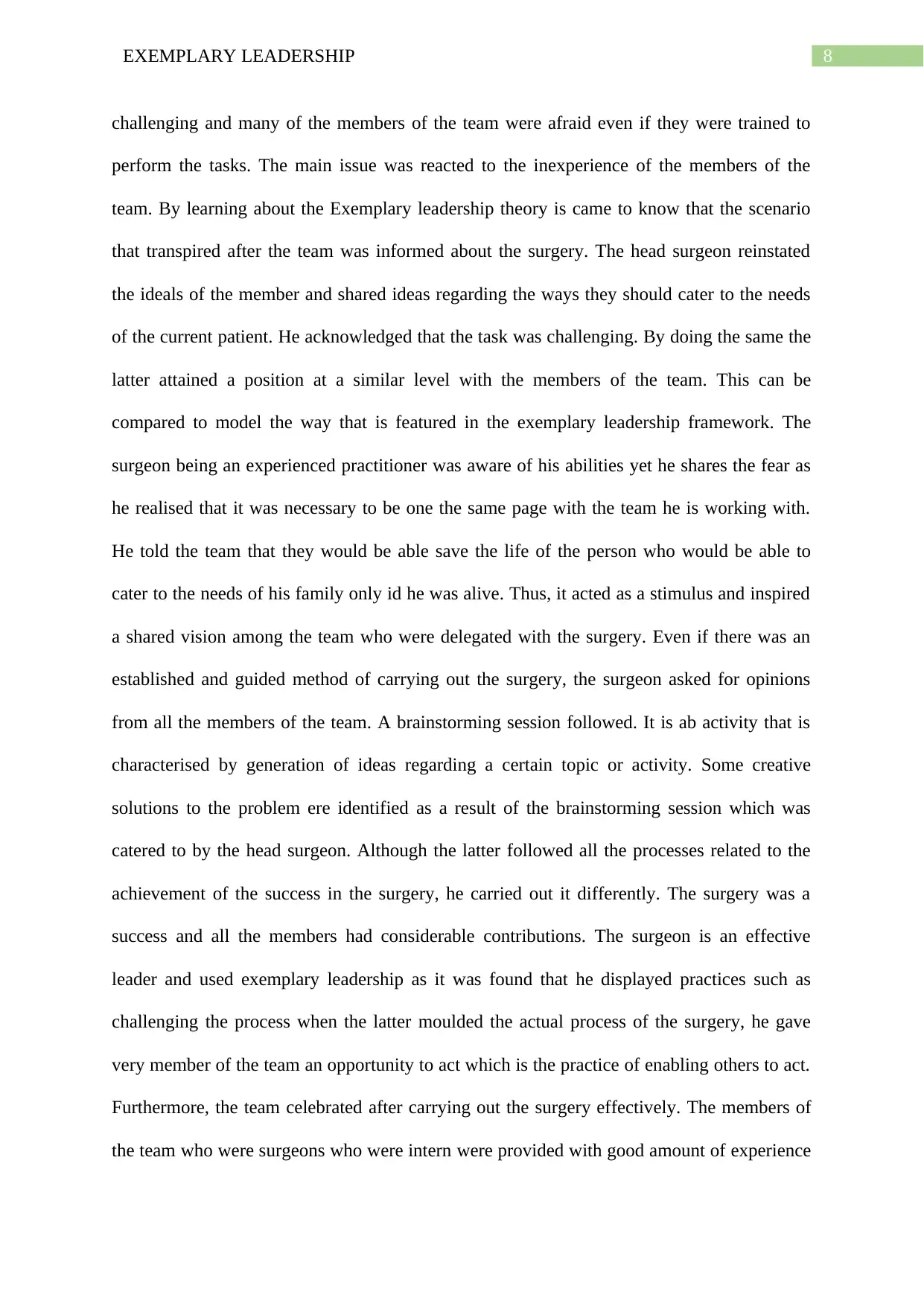
8EXEMPLARY LEADERSHIP
challenging and many of the members of the team were afraid even if they were trained to
perform the tasks. The main issue was reacted to the inexperience of the members of the
team. By learning about the Exemplary leadership theory is came to know that the scenario
that transpired after the team was informed about the surgery. The head surgeon reinstated
the ideals of the member and shared ideas regarding the ways they should cater to the needs
of the current patient. He acknowledged that the task was challenging. By doing the same the
latter attained a position at a similar level with the members of the team. This can be
compared to model the way that is featured in the exemplary leadership framework. The
surgeon being an experienced practitioner was aware of his abilities yet he shares the fear as
he realised that it was necessary to be one the same page with the team he is working with.
He told the team that they would be able save the life of the person who would be able to
cater to the needs of his family only id he was alive. Thus, it acted as a stimulus and inspired
a shared vision among the team who were delegated with the surgery. Even if there was an
established and guided method of carrying out the surgery, the surgeon asked for opinions
from all the members of the team. A brainstorming session followed. It is ab activity that is
characterised by generation of ideas regarding a certain topic or activity. Some creative
solutions to the problem ere identified as a result of the brainstorming session which was
catered to by the head surgeon. Although the latter followed all the processes related to the
achievement of the success in the surgery, he carried out it differently. The surgery was a
success and all the members had considerable contributions. The surgeon is an effective
leader and used exemplary leadership as it was found that he displayed practices such as
challenging the process when the latter moulded the actual process of the surgery, he gave
very member of the team an opportunity to act which is the practice of enabling others to act.
Furthermore, the team celebrated after carrying out the surgery effectively. The members of
the team who were surgeons who were intern were provided with good amount of experience
challenging and many of the members of the team were afraid even if they were trained to
perform the tasks. The main issue was reacted to the inexperience of the members of the
team. By learning about the Exemplary leadership theory is came to know that the scenario
that transpired after the team was informed about the surgery. The head surgeon reinstated
the ideals of the member and shared ideas regarding the ways they should cater to the needs
of the current patient. He acknowledged that the task was challenging. By doing the same the
latter attained a position at a similar level with the members of the team. This can be
compared to model the way that is featured in the exemplary leadership framework. The
surgeon being an experienced practitioner was aware of his abilities yet he shares the fear as
he realised that it was necessary to be one the same page with the team he is working with.
He told the team that they would be able save the life of the person who would be able to
cater to the needs of his family only id he was alive. Thus, it acted as a stimulus and inspired
a shared vision among the team who were delegated with the surgery. Even if there was an
established and guided method of carrying out the surgery, the surgeon asked for opinions
from all the members of the team. A brainstorming session followed. It is ab activity that is
characterised by generation of ideas regarding a certain topic or activity. Some creative
solutions to the problem ere identified as a result of the brainstorming session which was
catered to by the head surgeon. Although the latter followed all the processes related to the
achievement of the success in the surgery, he carried out it differently. The surgery was a
success and all the members had considerable contributions. The surgeon is an effective
leader and used exemplary leadership as it was found that he displayed practices such as
challenging the process when the latter moulded the actual process of the surgery, he gave
very member of the team an opportunity to act which is the practice of enabling others to act.
Furthermore, the team celebrated after carrying out the surgery effectively. The members of
the team who were surgeons who were intern were provided with good amount of experience
⊘ This is a preview!⊘
Do you want full access?
Subscribe today to unlock all pages.

Trusted by 1+ million students worldwide
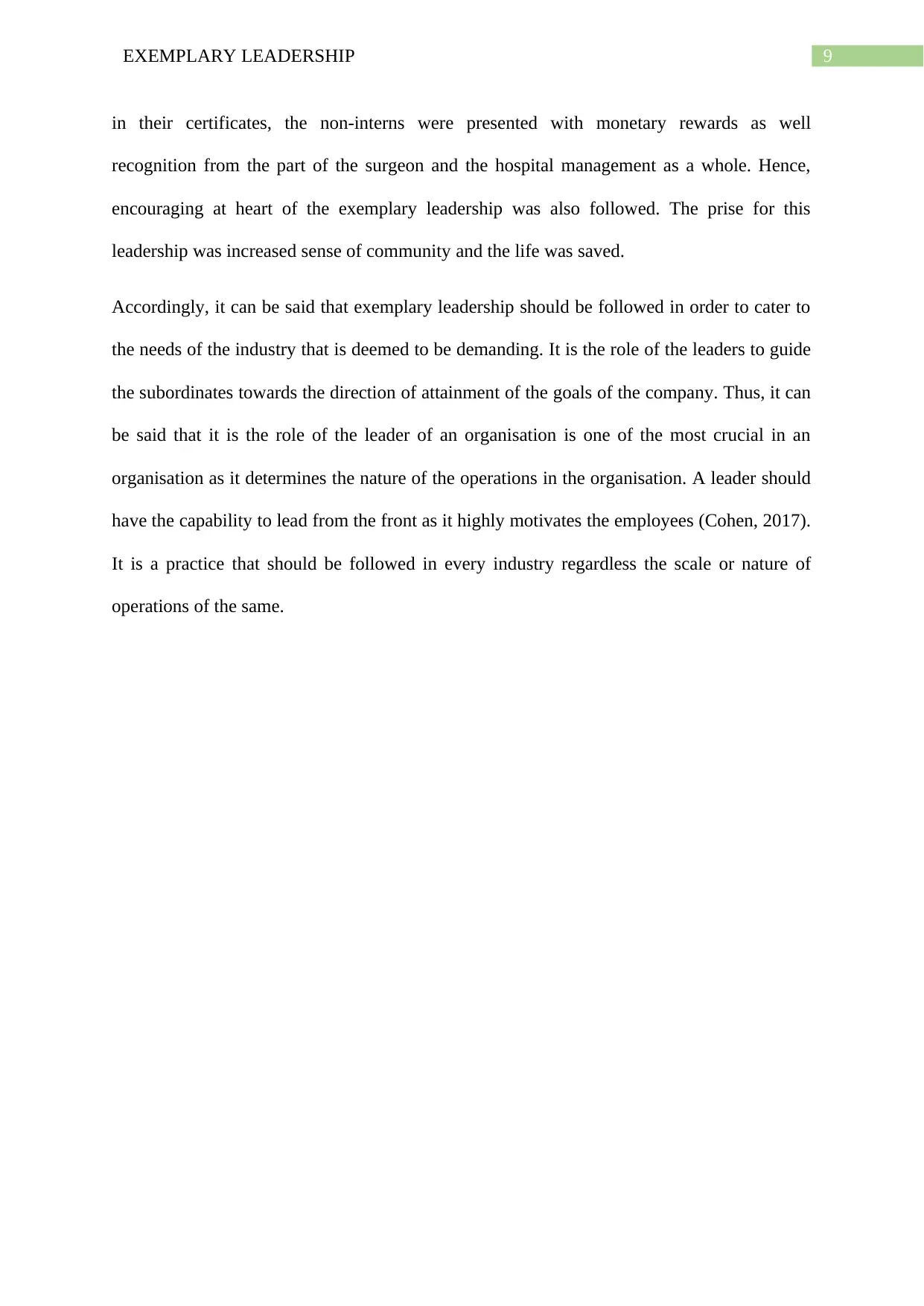
9EXEMPLARY LEADERSHIP
in their certificates, the non-interns were presented with monetary rewards as well
recognition from the part of the surgeon and the hospital management as a whole. Hence,
encouraging at heart of the exemplary leadership was also followed. The prise for this
leadership was increased sense of community and the life was saved.
Accordingly, it can be said that exemplary leadership should be followed in order to cater to
the needs of the industry that is deemed to be demanding. It is the role of the leaders to guide
the subordinates towards the direction of attainment of the goals of the company. Thus, it can
be said that it is the role of the leader of an organisation is one of the most crucial in an
organisation as it determines the nature of the operations in the organisation. A leader should
have the capability to lead from the front as it highly motivates the employees (Cohen, 2017).
It is a practice that should be followed in every industry regardless the scale or nature of
operations of the same.
in their certificates, the non-interns were presented with monetary rewards as well
recognition from the part of the surgeon and the hospital management as a whole. Hence,
encouraging at heart of the exemplary leadership was also followed. The prise for this
leadership was increased sense of community and the life was saved.
Accordingly, it can be said that exemplary leadership should be followed in order to cater to
the needs of the industry that is deemed to be demanding. It is the role of the leaders to guide
the subordinates towards the direction of attainment of the goals of the company. Thus, it can
be said that it is the role of the leader of an organisation is one of the most crucial in an
organisation as it determines the nature of the operations in the organisation. A leader should
have the capability to lead from the front as it highly motivates the employees (Cohen, 2017).
It is a practice that should be followed in every industry regardless the scale or nature of
operations of the same.
Paraphrase This Document
Need a fresh take? Get an instant paraphrase of this document with our AI Paraphraser
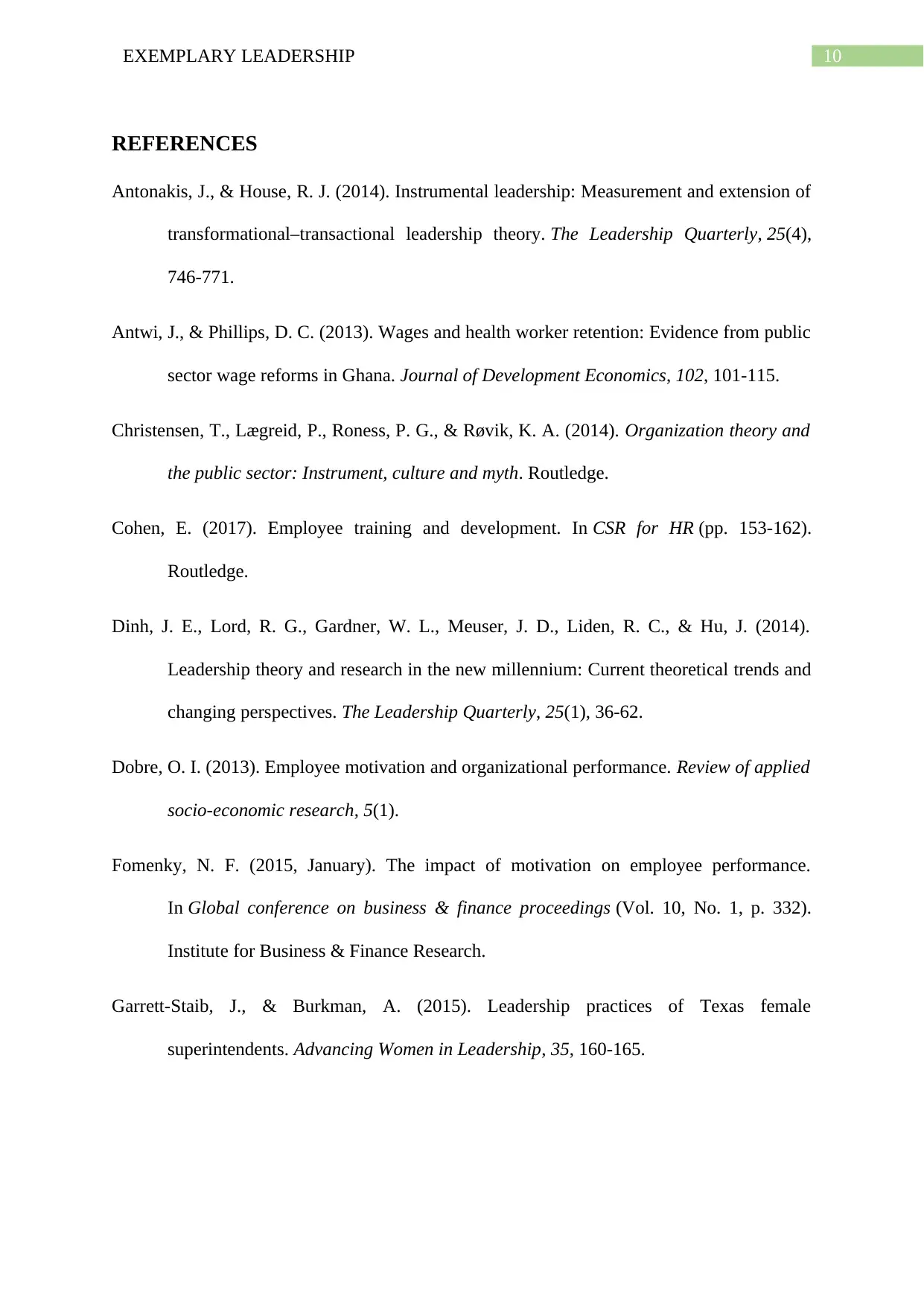
10EXEMPLARY LEADERSHIP
REFERENCES
Antonakis, J., & House, R. J. (2014). Instrumental leadership: Measurement and extension of
transformational–transactional leadership theory. The Leadership Quarterly, 25(4),
746-771.
Antwi, J., & Phillips, D. C. (2013). Wages and health worker retention: Evidence from public
sector wage reforms in Ghana. Journal of Development Economics, 102, 101-115.
Christensen, T., Lægreid, P., Roness, P. G., & Røvik, K. A. (2014). Organization theory and
the public sector: Instrument, culture and myth. Routledge.
Cohen, E. (2017). Employee training and development. In CSR for HR (pp. 153-162).
Routledge.
Dinh, J. E., Lord, R. G., Gardner, W. L., Meuser, J. D., Liden, R. C., & Hu, J. (2014).
Leadership theory and research in the new millennium: Current theoretical trends and
changing perspectives. The Leadership Quarterly, 25(1), 36-62.
Dobre, O. I. (2013). Employee motivation and organizational performance. Review of applied
socio-economic research, 5(1).
Fomenky, N. F. (2015, January). The impact of motivation on employee performance.
In Global conference on business & finance proceedings (Vol. 10, No. 1, p. 332).
Institute for Business & Finance Research.
Garrett-Staib, J., & Burkman, A. (2015). Leadership practices of Texas female
superintendents. Advancing Women in Leadership, 35, 160-165.
REFERENCES
Antonakis, J., & House, R. J. (2014). Instrumental leadership: Measurement and extension of
transformational–transactional leadership theory. The Leadership Quarterly, 25(4),
746-771.
Antwi, J., & Phillips, D. C. (2013). Wages and health worker retention: Evidence from public
sector wage reforms in Ghana. Journal of Development Economics, 102, 101-115.
Christensen, T., Lægreid, P., Roness, P. G., & Røvik, K. A. (2014). Organization theory and
the public sector: Instrument, culture and myth. Routledge.
Cohen, E. (2017). Employee training and development. In CSR for HR (pp. 153-162).
Routledge.
Dinh, J. E., Lord, R. G., Gardner, W. L., Meuser, J. D., Liden, R. C., & Hu, J. (2014).
Leadership theory and research in the new millennium: Current theoretical trends and
changing perspectives. The Leadership Quarterly, 25(1), 36-62.
Dobre, O. I. (2013). Employee motivation and organizational performance. Review of applied
socio-economic research, 5(1).
Fomenky, N. F. (2015, January). The impact of motivation on employee performance.
In Global conference on business & finance proceedings (Vol. 10, No. 1, p. 332).
Institute for Business & Finance Research.
Garrett-Staib, J., & Burkman, A. (2015). Leadership practices of Texas female
superintendents. Advancing Women in Leadership, 35, 160-165.
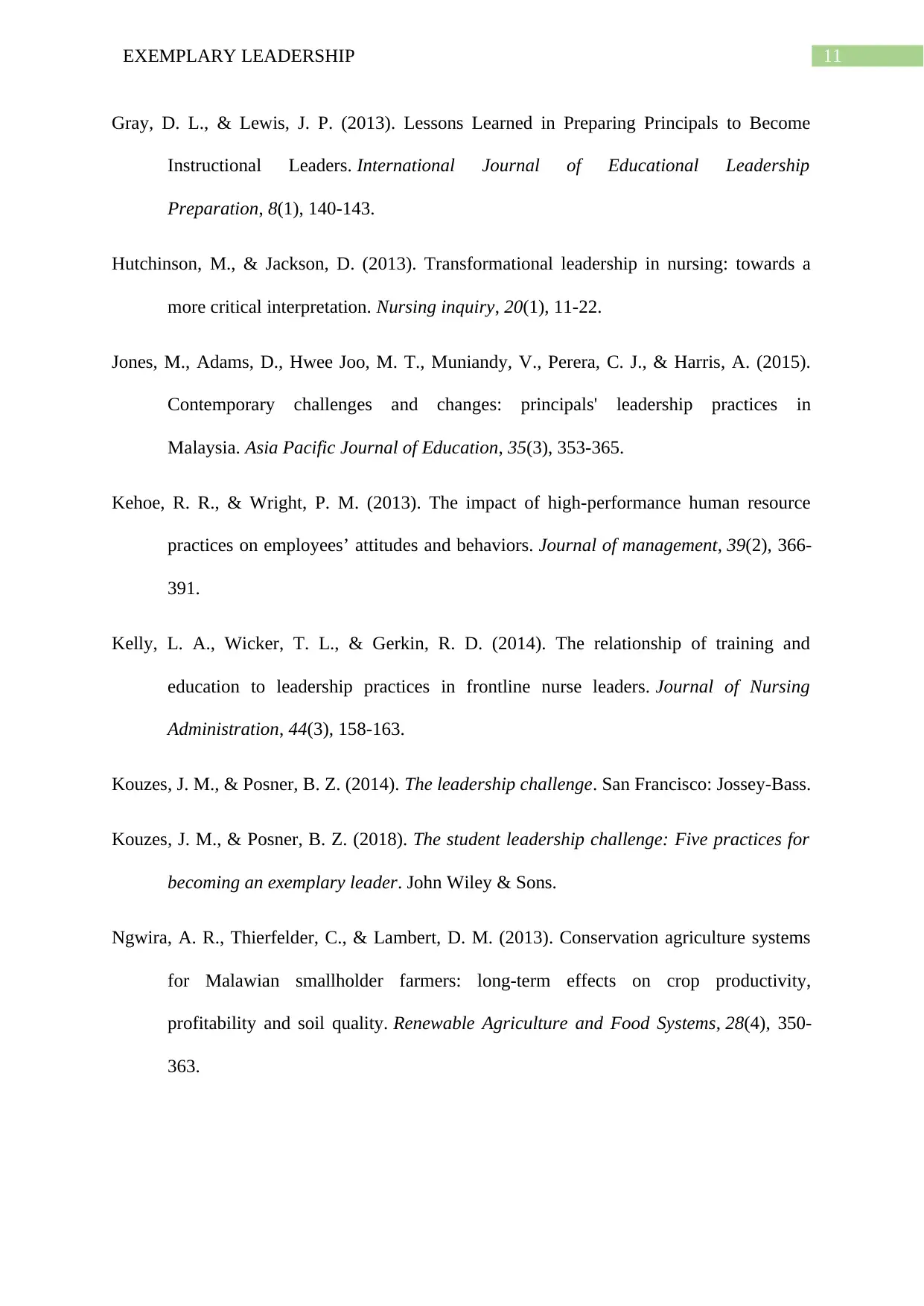
11EXEMPLARY LEADERSHIP
Gray, D. L., & Lewis, J. P. (2013). Lessons Learned in Preparing Principals to Become
Instructional Leaders. International Journal of Educational Leadership
Preparation, 8(1), 140-143.
Hutchinson, M., & Jackson, D. (2013). Transformational leadership in nursing: towards a
more critical interpretation. Nursing inquiry, 20(1), 11-22.
Jones, M., Adams, D., Hwee Joo, M. T., Muniandy, V., Perera, C. J., & Harris, A. (2015).
Contemporary challenges and changes: principals' leadership practices in
Malaysia. Asia Pacific Journal of Education, 35(3), 353-365.
Kehoe, R. R., & Wright, P. M. (2013). The impact of high-performance human resource
practices on employees’ attitudes and behaviors. Journal of management, 39(2), 366-
391.
Kelly, L. A., Wicker, T. L., & Gerkin, R. D. (2014). The relationship of training and
education to leadership practices in frontline nurse leaders. Journal of Nursing
Administration, 44(3), 158-163.
Kouzes, J. M., & Posner, B. Z. (2014). The leadership challenge. San Francisco: Jossey-Bass.
Kouzes, J. M., & Posner, B. Z. (2018). The student leadership challenge: Five practices for
becoming an exemplary leader. John Wiley & Sons.
Ngwira, A. R., Thierfelder, C., & Lambert, D. M. (2013). Conservation agriculture systems
for Malawian smallholder farmers: long-term effects on crop productivity,
profitability and soil quality. Renewable Agriculture and Food Systems, 28(4), 350-
363.
Gray, D. L., & Lewis, J. P. (2013). Lessons Learned in Preparing Principals to Become
Instructional Leaders. International Journal of Educational Leadership
Preparation, 8(1), 140-143.
Hutchinson, M., & Jackson, D. (2013). Transformational leadership in nursing: towards a
more critical interpretation. Nursing inquiry, 20(1), 11-22.
Jones, M., Adams, D., Hwee Joo, M. T., Muniandy, V., Perera, C. J., & Harris, A. (2015).
Contemporary challenges and changes: principals' leadership practices in
Malaysia. Asia Pacific Journal of Education, 35(3), 353-365.
Kehoe, R. R., & Wright, P. M. (2013). The impact of high-performance human resource
practices on employees’ attitudes and behaviors. Journal of management, 39(2), 366-
391.
Kelly, L. A., Wicker, T. L., & Gerkin, R. D. (2014). The relationship of training and
education to leadership practices in frontline nurse leaders. Journal of Nursing
Administration, 44(3), 158-163.
Kouzes, J. M., & Posner, B. Z. (2014). The leadership challenge. San Francisco: Jossey-Bass.
Kouzes, J. M., & Posner, B. Z. (2018). The student leadership challenge: Five practices for
becoming an exemplary leader. John Wiley & Sons.
Ngwira, A. R., Thierfelder, C., & Lambert, D. M. (2013). Conservation agriculture systems
for Malawian smallholder farmers: long-term effects on crop productivity,
profitability and soil quality. Renewable Agriculture and Food Systems, 28(4), 350-
363.
⊘ This is a preview!⊘
Do you want full access?
Subscribe today to unlock all pages.

Trusted by 1+ million students worldwide
1 out of 13
Related Documents
Your All-in-One AI-Powered Toolkit for Academic Success.
+13062052269
info@desklib.com
Available 24*7 on WhatsApp / Email
![[object Object]](/_next/static/media/star-bottom.7253800d.svg)
Unlock your academic potential
Copyright © 2020–2026 A2Z Services. All Rights Reserved. Developed and managed by ZUCOL.
![Leadership Analysis: Kouzes and Posner Model Report, [University Name]](/_next/image/?url=https%3A%2F%2Fdesklib.com%2Fmedia%2Fimages%2Fhm%2Fafce88564314430eb83ad6a486b26457.jpg&w=256&q=75)




